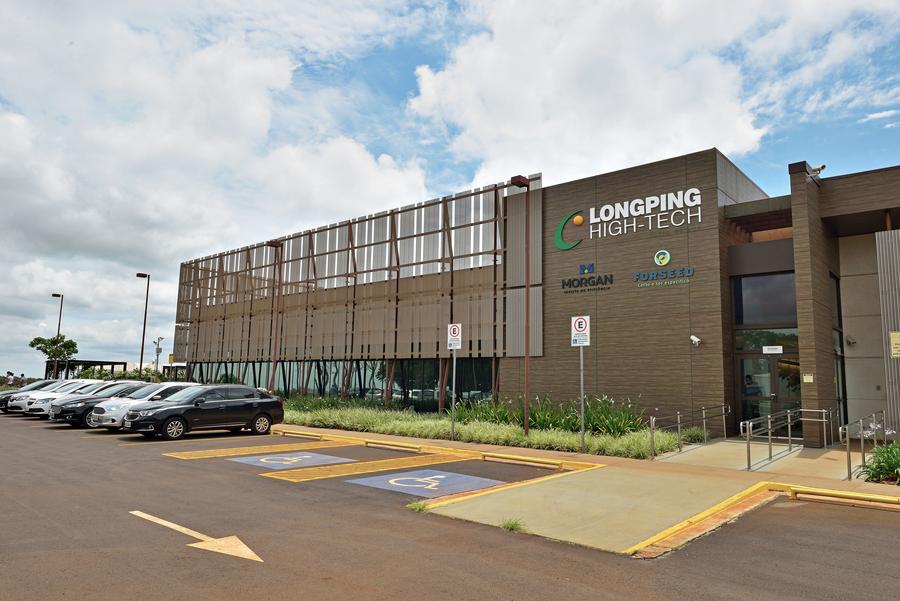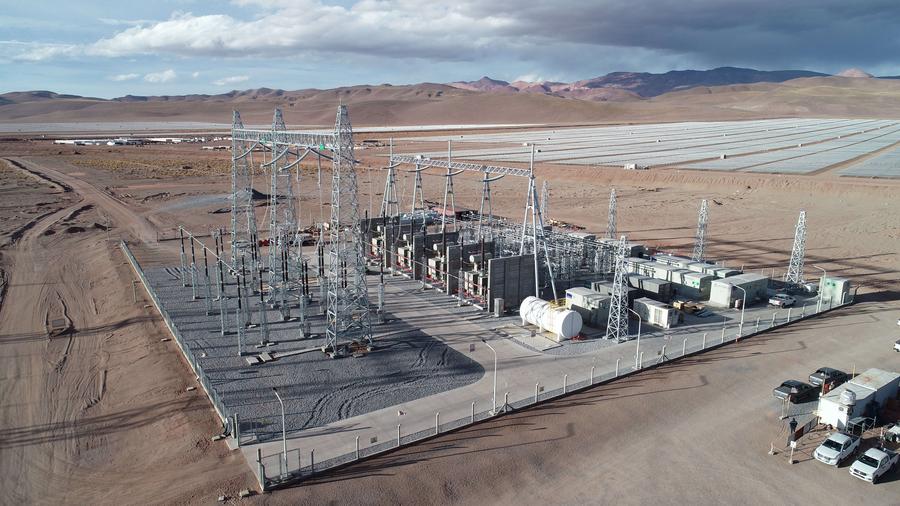
Chinese engineers and technicians with CRRC Qingdao Sifang Co., Ltd., together with their Argentine colleagues, inspect a train in Llavallol, some 33 km south of Buenos Aires, Argentina, Nov. 16, 2020. (Photo by Martin Zabala/Xinhua)
"The partnership between China and Latin America is a clear example of how international cooperation can generate important benefits for all parties involved," said Fausto Pinato, president of the Brazil-China Parliamentary Front of the Brazilian National Congress.
BEIJING, July 22 -- A decade ago, Chinese President Xi Jinping put forward the initiative of building a China-Latin America community with a shared future for the first time at the China-Latin American and Caribbean Countries Leaders' Meeting in Brasilia, Brazil.
"The fact that the leaders of China and so many Latin American and Caribbean countries are gathering here is in itself of historic and global significance," he said.
Recalling Xi's speech, Fausto Pinato, president of the Brazil-China Parliamentary Front of the Brazilian National Congress, said China's proposal to build a community with a shared future has demonstrated its important commitment to the region, based on a multilateral vision of the world.
"The partnership between China and Latin America is a clear example of how international cooperation can generate important benefits for all parties involved," he said.
PARTNERS FOR COMMON DEVELOPMENT
The shared dream and pursuit have brought China and Latin America closely together, said Xi ten years ago. Ever since then, both sides have been constantly moving even closer to each other.
Both China and Latin American states are developing countries and emerging economies at an important stage of development and revitalization.
China prizes its relations with Latin America, and has always regarded Latin American countries as important partners in consolidating the unity of developing countries and promoting South-South cooperation.
In June this year, Peruvian President Dina Boluarte paid her first state visit to China, bringing a delegation of key cabinet members and representatives from the economic sector.
In an interview, she talked about her vision for Peru's development -- "a country where children have a future," "reduce poverty," "no more hunger" ... After visiting Shenzhen, Shanghai, Suzhou and other places in China, she gained a personal experience of the achievements and prospects of the Chinese modernization, and also saw hope for her country's future.
 Photo taken on Jan. 18, 2021 shows Longping High-Tech Brazil, a Chinese-invested company owned by Longping Agriculture Science Co., Ltd., in Cravinhos, Brazil. (Xinhua)
Photo taken on Jan. 18, 2021 shows Longping High-Tech Brazil, a Chinese-invested company owned by Longping Agriculture Science Co., Ltd., in Cravinhos, Brazil. (Xinhua)
Over the past decade, China and Latin America have maintained close high-level exchanges and strategic communications, injecting constant impetus into the China-Latin America comprehensive cooperative partnership featuring equality, mutual benefit and common development.
Since 2023, Xi has interacted with the heads of state of Brazil, Venezuela, Chile, Argentina, Colombia, Peru and other Latin American countries, either in face-to-face meetings or through letters, messages and phone talks. "Cooperation" and "development" have been the most frequently used words on these occasions.
In recent years, five Latin American countries, namely Panama, Dominica, El Salvador, Nicaragua and Honduras, have established or restored diplomatic ties with China. China and an increasing number of Latin American partners are working together to create a new pattern of China-Latin America relations featuring sincerity and mutual trust in politics, win-win cooperation in economy and trade, mutual learning in people-to-people exchanges, close coordination in international affairs, and mutual enhancement of overall cooperation and bilateral relations.
For Penildon Silva Filho, a professor at the Federal University of Bahia, the intense visits of heads of state and senior officials from Latin American countries to China confirmed once again the trend of "Looking to the East."
"China's relationship with Latin America is part of a new framework, in a new situation, in the creation of a multipolar world. Asia is today the great economic engine of the planet. So, in this sense, a greater relationship is justified between Latin American countries and China," said Silva Filho.
BOOMING TRADE TIES
China and Latin America have enjoyed strong economic and trade complementarities, making them natural trade partners. China has been Latin America's second-largest trading partner since 2012. The trade volume between China and Latin America last year exceeded 489 billion U.S. dollars.
In recent years, China-Latin America economic and trade cooperation has expanded from traditional fields to new energy, digital technology, and cross-border e-commerce, among others.
China has inked free trade agreements with Peru, Chile, Costa Rica, Ecuador and Nicaragua. So far, China's number of free trade partners in Latin America is second only to Asia.
This year, China held the fifth round of negotiations on the China-Honduras Free Trade Agreement and completed substantive negotiations on upgrading the free trade agreement with Peru.
 Aerial photo taken on June 12, 2020 shows a view of Cauchari Solar Park in the northwestern province of Jujuy, Argentina. Cauchari Solar Park, built by China Power Construction and the Shanghai Electric Power Construction Company, is located in the town of Cauchari in the northwestern province of Jujuy, at an altitude of about 4,200 meters above sea level. (Xinhua)
Aerial photo taken on June 12, 2020 shows a view of Cauchari Solar Park in the northwestern province of Jujuy, Argentina. Cauchari Solar Park, built by China Power Construction and the Shanghai Electric Power Construction Company, is located in the town of Cauchari in the northwestern province of Jujuy, at an altitude of about 4,200 meters above sea level. (Xinhua)
China-Latin America financial cooperation continues to deepen, and the internationalization of the Renminbi is steadily advancing in Latin America. China has signed bilateral currency swap agreements with the central banks of Argentina and Chile.
Chinese banks, including the Bank of China and the Industrial and Commercial Bank of China, have opened branches in many Latin American countries.
Renzo Burotto, a historian from the University of Chile, said that the economic and commercial relations between China and Latin America are highly complementary.
China is one of Latin America's main trade partners, a supplier of goods and capital, and a strategic partner for the development of industries such as renewable energies, Burotto said.
BELT AND ROAD
Xi has stressed on many occasions that China is willing to work with Latin America to promote the Belt and Road cooperation to further bilateral ties.
So far, 22 Latin American and Caribbean countries have signed Belt and Road cooperation documents with China, which has benefited the people of those countries.
For instance, Botopasi, a remote village in central Suriname, used to experience frequent power outages and dozens of villages in the region had long relied on diesel power generation, with electricity available for only a few hours each day.
With the help of Chinese workers, this situation has improved. Village by village, they have built microgrid photovoltaic hybrid power stations for the region, bringing 24-hour electricity supply to thousands of locals.
Projects jointly built under the Belt and Road Initiative, including the Belo Monte Hydropower Plant ultra-high-voltage transmission line project in Brazil, Argentina's Belgrano Cargas railway and the Jamaica North-South Highway, have greatly benefited local people and beyond.
In recent years, bilateral Belt and Road cooperation has grown increasingly green.
This photo taken on Jan. 10, 2024 shows buildings inside the Phoenix Park Industrial Estate in Point Lisas, the second-largest port in Trinidad and Tobago. (Xinhua/Zhu Wanjun)
In Peru, the main mobile equipment of the Chancay Harbor project under construction by Chinese enterprises is driven by pure electricity, reducing the idle consumption of related equipment through intelligent systems. In Trinidad and Tobago, the Phoenix Park Industrial Estate built by Chinese enterprises has become the first industrial park in Latin America to be covered by a 5G network and is also equipped with solar street lights, high-standard sewage treatment systems and other environmental protection facilities.
Fernando Fazzolari, a member of the Argentine-Chinese Chamber of Production, Industry and Commerce, said the Belt and Road cooperation has been popular in Latin America and the Caribbean due to its adherence to the principle of extensive consultation, joint contribution and shared benefits and its focus on mutual benefits.
"VISITING RELATIVES AND FRIENDS"
"Although China and Latin America and the Caribbean are far apart geographically, there is a natural feeling of affinity between our peoples," President Xi said during his Latin America trip ten years ago, describing it as "visiting relatives and friends."
Over the past decade, within the framework of the China-Latin America Forum, China and Latin America have built a comprehensive, multi-level, and wide-ranging dialogue and cooperation network, with exchanges between people on both sides increasing.
Since the beginning of this year, the first China-Latin American and Caribbean States Space Cooperation Forum has been held successfully; a new batch of agricultural cooperation projects has been planned at the China-LAC Agricultural Ministers' Forum.
Besides, China has recently added or resumed several direct flights to countries such as Brazil, Mexico, and Cuba, to facilitate personnel exchanges.
Raquel Leon de la Rosa, an expert on China issues from the Meritorious Autonomous University of Puebla, Mexico, believes that this reflects "greater dynamism" in terms of economic, cultural, political and technological cooperation.
"These flights allow us to reduce, as best as possible, these geographical distances that may exist, and this opens an important communication and connectivity channel," De la Rosa said.











